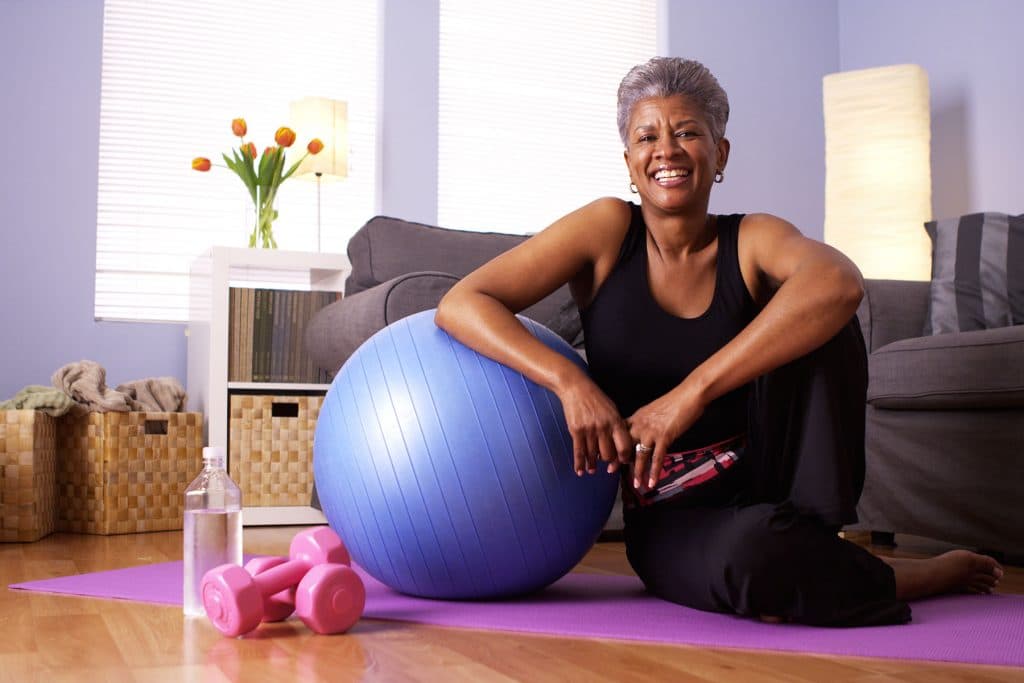7 Reasons Strength Training Is Vital For Women In Midlife

Strength training. You’ve probably heard lots of advice about the benefits for women in midlife and it’s for good reason. Prevention is always better than cure, particularly in peri- and post-menopause.
This exercise – aka resistance training – can make a big difference to your body size, bone health and balance. Of course, exercise also helps to protect against chronic diseases such as osteoporosis, osteopenia (low bone density), Type 2 diabetes and heart disease in women.
In addition, it makes us stronger, happier and more vital!
What’s more, the earlier you start the more benefits you build over time – puberty’s a good time to begin so share with your daughters/granddaughters/nieces/colleagues!
According to The Endocrine Society 1 in 2 post-menopausal women will have osteoporosis. Yet, one American study found that only 1 in 5 women practise strength training.
Motion Is Lotion
We understand that you may not know how you would fit strength training into your life especially if you’re not an athlete or avid exerciser. And if you’ve got aching muscles and joints it’s probably the last thing you feel like doing but as they say:
“Motion is lotion” and “rest is rust”.
So please keep reading because it doesn’t have to be all about being a bodybuilder or gym bunny. Indeed, bodybuilding is a training all of its own and not one for the faint-hearted!
As always, we aim to make this simple and achievable for you wherever you’re at.
1. What Is Strength Training?
Any physiological movement that uses bodyweight or equipment to engage your muscles.
Read that again.
Basically, strength training works by putting stress and load on the bone and muscles. As a result, they respond positively. So if your muscles are holding weight – be that a dumbbell or your body weight – they’ll increase bone density and muscle mass.
Building strength improves your muscle tone and bone density and decreases your risk of falls as you grow older.
In fact, you probably already do some form of strength training.
Think walking. Though not a heavy hitter, it’s a form of strength training for your legs especially if you add ankle weights.
Or swimming. Definitely strength training due to the resistance of the water.
Yoga, Pilates? Without a doubt, these techniques engage your muscles. If you’ve ever done a sun salutation you know the strength it takes.
And then there are kettlebells, tennis, tai chi (which is brilliant for balance) and resistance bands.
There is a multitude of options so it doesn’t have to be all about the gym and dumbbells (although lifting weights is a fantastic form).
2. How much and how often should you be strength training?
The general advice for women in midlife is at least two times a week.
And from a cortisol perspective, it’s a good idea to make your workouts short and intense. This is because working out too hard for too long can trigger the stress hormone, disrupting metabolism and immune response.

The World Health Organisation’s exercise guidelines recommend adults do muscle-strengthening movements for two or more days a week. They up this to three or more days per week for those over 65 to help prevent fall risk.
The New Zealand Ministry of Health also recommends strength training two days per week as does Australia’s Department of Health.
However, that’s a broad overview for both genders so for women at risk of osteoporosis and sarcopenia due to decreasing estrogen it’s suggested you aim a little higher.
At this stage, it would be great to follow the advice of a female personal trainer who specialises in women in midlife. If the gym’s not your thing there are some great options online including Debra Atkinson at Flipping Fifty and Dr Maria Lurque of Fitness In Menopause.
3. Why is strength training so vital in midlife?
Women over 40 begin to lose 1% of their lean muscle mass every year. According to Harvard, this can begin even earlier, at around 35.
Furthermore, during perimenopause, the loss of muscle and bone density increases. Once you go through into post-menopause the estrogen loss accelerates and the decrease in muscle and bone mass is turbo-charged.
Subsequently, both your muscles and skeleton grow weaker which, in turn, makes you more at risk of osteoporosis and fractures. Furthermore, your metabolism slows down, the fat ratio increases and if you don’t have muscle strength your balance goes awry.
4. Why it’s better to begin strength training as early as possible.

New research published in the journal Menopause, which we also refer to in 4 Ways To Prepare Your Body For Perimenopause, has shown how working out affects your body composition and metabolism.
The study looked at 72 women aged 35-60 women in pre-, peri- and post-menopause. It recorded their physical activity and looked at fat mass, lean mass, bone and total body water content. (In previous studies DEXA only looked at fat mass and lean mass).
Overall, they measured hormone levels, diet, menopausal symptoms, exercise, fat distribution, body composition and resting metabolic rate.
It may not be surprising that the women in perimenopause had more belly fat (16%) than premenopausal women. However, it’s interesting that they only had 5% more than the women in post-menopause.
Furthermore, the premenopausal women’s fat mass was 7.1kg compared to 1.4kg higher in the post-menopause women who also had 6.1 kg less muscle mass than the premenopause group.
Additionally, the perimenopause women had a higher fat mass and lower muscle mass than pre- and post-menopausal women.
The result? The study concluded that menopausal women may be able to counteract muscle loss and unwanted metabolic issues by practising strength and HIIT training.
Watch the graphs and details of the study from the North American Menopause Society.
5. Are you eating enough to complement your strength training?
Most of the conversations we have about exercise swing around to weight and metabolism at some stage. Weight gain is a common concern and we often see women gain weight post-40 then go on restricted diets and over-exercise. With zero ‘wriggle room’.
Is this you?
If it is, it’s hardly surprising. After all, it always used to work, right?
The diet industry is a multi-million dollar beast confusing you with keto, paleo and low carb protocols as well as tons of conflicting information.
We always advise keeping it simple unless you’re working with a specialist well-versed in a way of eating because diets can be dangerous.
As with menopause, there is no one-size-fits-all when it comes to dieting. For example, some studies have shown keto and paleo decrease lean muscle mass and keto/low carb has been linked to thyroid issues. By the same token, the opposite information has been found. There are examples like this for most methods which is why it’s important to consult a specialist in the principle. We are all bio-individuals and what works for one person won’t help another thrive.
Also, at the risk of sounding like a broken record, avoiding processed foods, getting rid of refined sugars and carbohydrates (because all carbs except fibre are turned into sugar), eating plenty of vegetables, a couple of pieces of fruit and moderating red meat is key. Indeed, the Mediterranean Diet consistently comes up trumps for women in peri- and post-menopause. Additionally, it’s been linked to higher bone density and muscle mass.
Protein’s Important
When it comes to strength training it’s important to focus on your lean protein intake too. Protein not only keeps you fuller for longer, but it’s crucial to growing and repairing muscle mass and bone health.
Good sources of protein include eggs, hormone-free chicken, fish, edamame beans, hummus, chickpeas, tempeh, lentils and cottage cheese.
Athlete, exercise physiologist and nutrition scientist Dr Stacy Sims recommends at least 1.8 to 2 grams of protein per kilogram of weight a day, which is about 30 grams at each meal, and 15 to 20 grams with snacks. To break that down visibly, a palm-sized portion is about 20-30 grams.
6. Don’t overdo your strength training
Yes, exercise is wonderful for your health and a robust skeleton, lean muscle and agility. But it is possible to overdo it.
More is not better as it could hurt you. One reason working with a professional is a good idea.

If you’re overdoing it, exercise stress can make you lose strength and stamina, spike cortisol, lead to burnout, contribute to belly fat, stop you from sleeping and make you feel constantly hungry and irritated. It also causes oxidative stress in the body which escalates ageing.
Not the goal really, is it?
A Fitbit or Apple Watch is a great tool as they can tell you your heart rate – if it’s higher than normal when you’re resting you could be doing too much exercise.
7. Habit stacking for strength training novices
“We are what we repeatedly do. Excellence, then, is not an act, but a habit.” — Aristotle
OK, onto a behavioural science strategy to make your strength training more doable for you.
If you’re not doing strength training, or not as regularly as you’d like, you can create a new habitual pathway.
Habit stacking is about making small changes associated with something you do in your daily regime.
For example, you always get up in the morning. So putting on your exercise gear straight away (if you don’t have to race to work) will put you in strength training mode.
By the same token, it could be that you do your training at the end of your day so you take your workout gear to work.
Repetition is the key. As a rule, it takes small, repetitive steps to form new habits.
Habits are formed by a sequence of neurons we create in our brain. They nudge us to do the same thing at the same time every day.

James Clear, a behavioural psychologist and author of Atomic Habits – Tiny Changes Remarkable Results, says habits are the compound interest of self-improvement. According to James, getting 1 percent better every day counts for a lot in the long run.
“Adults go through a process called synaptic pruning. This means our brain prunes away connections between neurons that don’t get used and builds those that are more regularly used.”
So the more you do something the stronger that connection becomes. Therefore if you diarise your workouts into your day – just start small – pretty soon it should become routine.
An example
(make your own to suit your life):
- Wake up
- 5 minutes of meditation, journaling or breathing
- Take Perky Post®/Merry Peri®/LotsaLocks®
- Brush teeth
- Shower now or…
- Put on exercise gear
- Practise yoga, Pilates, strength training on YouTube or head to the gym
- …shower now
Finally, the old adage tells us that it takes 21 days to form a habit but science says it’s more like 66 days.
Conclusion
A must watch. Dr Stacy Sims’ TEDx Talk Women Are Not Small Men is great.
The American study we mentioned earlier found that only about 20% of women are taking part in strength training. And when you consider how this can contribute to weakness, fractures and falls it’s pretty disconcerting.
The self-esteem benefits of strength training are huge too because you’ll feel strong and look better naked (if that’s important to you). Studies show resistance training ups self-image.
If strength training is all-new for you, realise your training doesn’t have to be perfect because it all counts.
What do you think? Is strength training for you?










